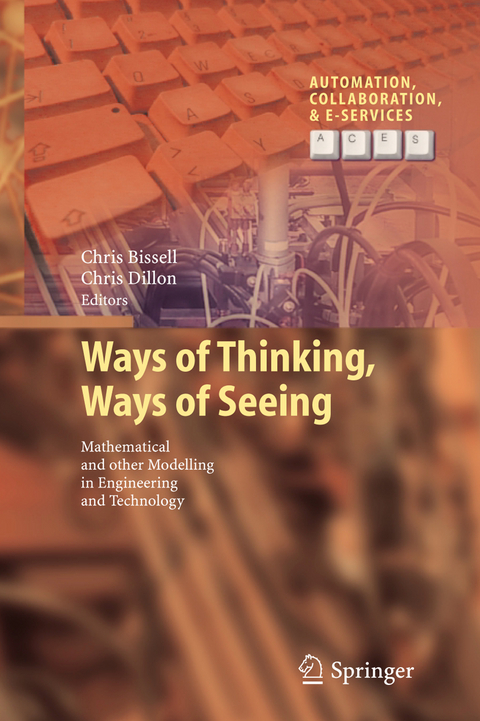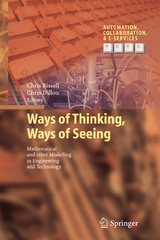Ways of Thinking, Ways of Seeing
Mathematical and other Modelling in Engineering and Technology
Seiten
2012
|
2012
Springer Berlin (Verlag)
978-3-642-25208-2 (ISBN)
Springer Berlin (Verlag)
978-3-642-25208-2 (ISBN)
This fascinating book examines some of the characteristics of technological/engineering models that are likely to be unfamiliar to those who are interested primarily in the history and philosophy of science and mathematics, and which differentiate technological models from scientific and mathematical ones. Themes that are highlighted include:
- the role of language: the models developed for engineering design have resulted in new ways of talking about technological systems
- communities of practice: related to the previous point, particular engineering communities have particular ways of sharing and developing knowledge
- graphical (re)presentation: engineers have developed many ways of reducing quite complex mathematical models to more simple representations
- reification: highly abstract mathematical models are turned into 'objects' that can be manipulated almost like components of a physical system
- machines: not only the currently ubiquitous digital computer, but also older analogue devices - slide rules, physical models, wind tunnels and other small-scale simulators, as well as mechanical, electrical and electronic analogue computers
- mathematics and modelling as a bridging tool between disciplines
This book studies primarily modelling in technological practice. It is worth noting that models of the type considered in the book are not always highly valued in formal engineering education at university level, which often takes an "applied science" approach close to that of the natural sciences (something that can result in disaffection on the part of students). Yet in an informal context, such as laboratories, industrial placements, and so on, a very different situation obtains. A number of chapters considers such epistemological aspects, as well as the status of different types of models within the engineering education community.
The book will be of interest topractising engineers and technologists; sociologists of science and technology; and historians and philosophers of science and mathematics. It will also be written in a way that will be accessible to non-specialists.
- the role of language: the models developed for engineering design have resulted in new ways of talking about technological systems
- communities of practice: related to the previous point, particular engineering communities have particular ways of sharing and developing knowledge
- graphical (re)presentation: engineers have developed many ways of reducing quite complex mathematical models to more simple representations
- reification: highly abstract mathematical models are turned into 'objects' that can be manipulated almost like components of a physical system
- machines: not only the currently ubiquitous digital computer, but also older analogue devices - slide rules, physical models, wind tunnels and other small-scale simulators, as well as mechanical, electrical and electronic analogue computers
- mathematics and modelling as a bridging tool between disciplines
This book studies primarily modelling in technological practice. It is worth noting that models of the type considered in the book are not always highly valued in formal engineering education at university level, which often takes an "applied science" approach close to that of the natural sciences (something that can result in disaffection on the part of students). Yet in an informal context, such as laboratories, industrial placements, and so on, a very different situation obtains. A number of chapters considers such epistemological aspects, as well as the status of different types of models within the engineering education community.
The book will be of interest topractising engineers and technologists; sociologists of science and technology; and historians and philosophers of science and mathematics. It will also be written in a way that will be accessible to non-specialists.
Creating reality.- Dimensional analysis and dimensional reasoning.- Models: what do engineers see in them?.- Metatools for information engineering design.- Early computational modelling: physical models, electrical analogies and analogue computers.- Expanding the concept of 'model': the transfer from technological to human domains within systems.- Visualisations for understanding complex economic systems.- The inner world of models and its epistemic diversity: infectious disease and climate modelling.- Modelling with experience: construal and construction for software.
| Erscheint lt. Verlag | 4.2.2012 |
|---|---|
| Reihe/Serie | Automation, Collaboration, & E-Services |
| Zusatzinfo | XIV, 234 p. |
| Verlagsort | Berlin |
| Sprache | englisch |
| Maße | 155 x 235 mm |
| Gewicht | 475 g |
| Themenwelt | Informatik ► Theorie / Studium ► Künstliche Intelligenz / Robotik |
| Mathematik / Informatik ► Mathematik ► Angewandte Mathematik | |
| Technik ► Elektrotechnik / Energietechnik | |
| Technik ► Maschinenbau | |
| Schlagworte | Mathematical Modelling in Engineering and Technology • Mathematisches Modell |
| ISBN-10 | 3-642-25208-7 / 3642252087 |
| ISBN-13 | 978-3-642-25208-2 / 9783642252082 |
| Zustand | Neuware |
| Haben Sie eine Frage zum Produkt? |
Mehr entdecken
aus dem Bereich
aus dem Bereich
was sie kann & was uns erwartet
Buch | Softcover (2023)
C.H.Beck (Verlag)
18,00 €
von absurd bis tödlich: Die Tücken der künstlichen Intelligenz
Buch | Softcover (2023)
Heyne (Verlag)
20,00 €




